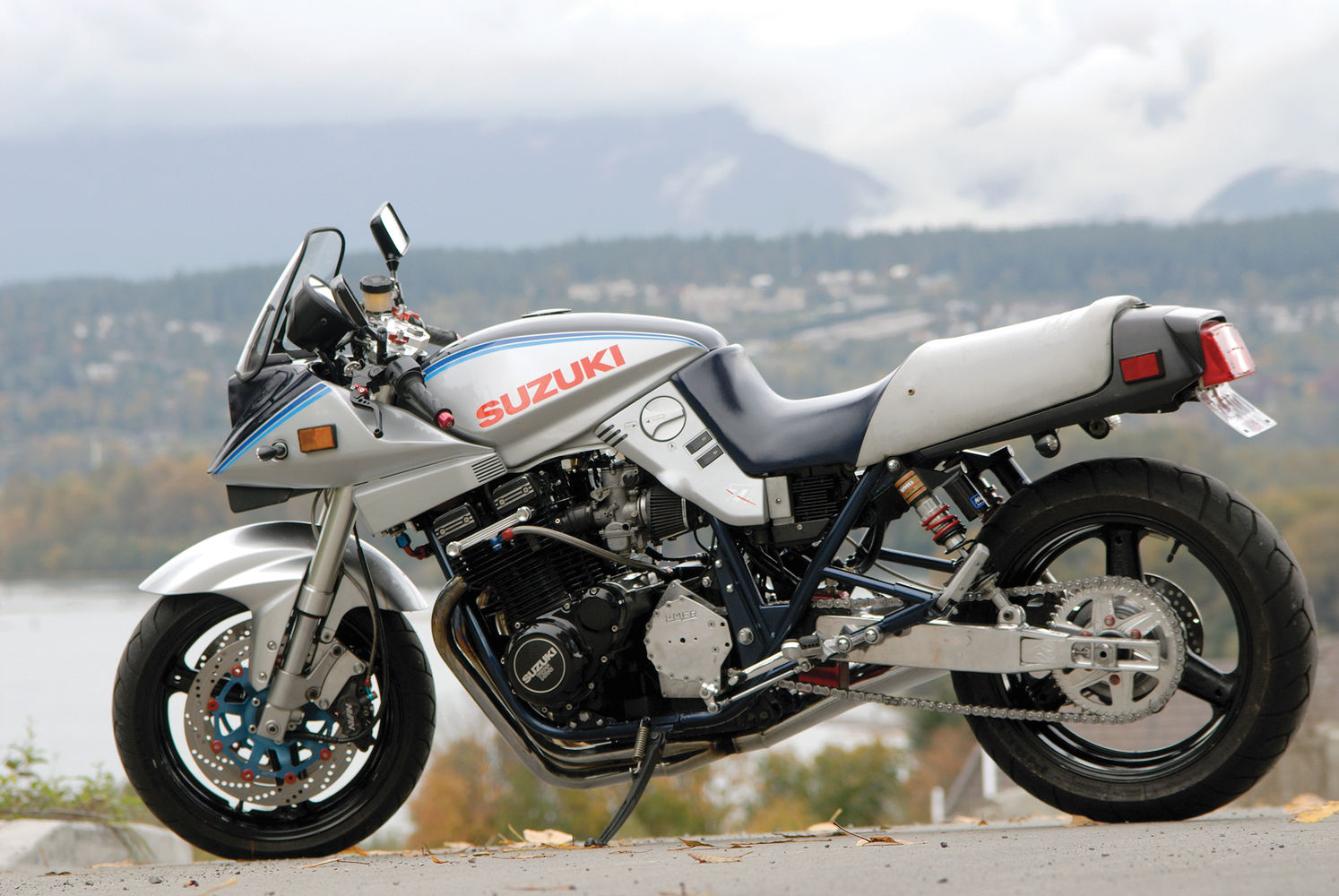Review: 1983 Suzuki Katana Custom

Fans of the long-running TV sci-fi series Stargate SG-1 and the movie The Fantastic Four will likely have seen Rob Wilton on their screens without realizing it. You’re not usually supposed to recognize him.
Rob is a stunt coordinator and stunt performer with a long list of credits in the movie and TV industry, so when he does appear on the screen, he’s usually standing in for someone else. Making movies consists of lots of “hurry up and wait”—short bursts of activity with a good amount of down time in between. So what does Rob do to fill the hours between gigs? As a talented mechanic with a passion for early 80s Suzukis, Rob has made a name for himself as the builder of some of the finest custom Katanas around. Why Katanas?
“I kicked myself for selling my ‘82 Kat back in 1985,” says Rob. Ten years later he found a 1983 Katana 1100 “in a basket” and started a ground-up rebuild to his own custom specification.
“Just as some are into stockers, I dig an old base with modern upgrades,” says Rob. “I promptly blew through my budget, then tripled it!”
Rob doesn’t only build custom bikes for himself. He has at least three similar machines under his belt, with GS fans knocking on his door looking for replicas.
Suzuki was the last of the “Big Four” Japanese motorcycle manufacturers to produce an across-the-frame four-stroke overhead cam four, the configuration that became known as the “UJM” (Universal Japanese Motorcycle). But Suzuki’s approach to producing such machines differed substantially from its competitors. Borrowing from its long experience in two-stroke engines, Suzuki used a built-up crankshaft, running roller bearings in the mains, and big ends for its GS range. Though expensive and time-consuming to assemble, the GS crankshaft was stronger and more durable than the plain bearing cranks of the competition. (So strong, in fact, those Suzuki GS-based engines are still found in the fastest pro stock drag racing bikes.)
First of Suzuki’s four-stroke fours was the GS750, then came the classic GS1000, the GS850, and the GS1100. All established a reputation for bulletproof reliability and longevity, especially the G-suffix shaft drive machines.
Early GS bikes had double overhead camshafts with two valves per cylinder—state of the art when the GS750 arrived in 1976. But in 1979, Honda introduced a 16-valve DOHC design. Suzuki’s answer was a new 16-valve cylinder head with “TSCC” (Twin Swirl Combustion Chambers) introduced in 1980. This was sold as the GS in North America but in other markets as the GSX.
Until the early 80s, the Japanese “muscle bikes” came naked: sporting bodywork was exclusive of Italian and German manufacturers. (Though many a GS850G owner fitted a voluminous Vetter or Windjammer fairing, these were hardly sporting.) It was therefore a bold move by Suzuki to create a café racer, combining its powerful 16-valve motor with sporty, angular bodywork by Hans Muth. They called it “Katana” after the single-edged sword used by 15th century Samurai warriors.
The Katana was a critical and commercial success (even in the heyday of “custom” cruisers with stepped seats), so much so that it spawned imitators from the other Japanese manufacturers: Kawasaki’s GPZ range and Honda’s Vee-Four Sabre. However, Suzuki’s air-cooled four was reaching the end of its development; in 1984, the new GSX-R motor was introduced with SACS (Suzuki Advanced Cooling System) air/oil cooling. And though the widely popular GS850G was available for two more years, the original GS/GSX line was terminated.
Thus the older GS750S, GS1000S, and GS1100S Katanas are now becoming highly collectible, so Rob Wilton doesn’t like starting his custom projects from a complete bike. Hence the basket case.
“I started with frame bracing and powder coat,” he says, “then I said ‘let the games begin!’”
Billet Vortex 954 triple trees went on the front end clamping 1992 GSX-R forks, with Öhlins springs and valves fitted inside. The rear wheel is controlled by a 2002 Suzuki Bandit swingarm with Exoticycle drag-style extenders and Works Performance remote reservoir shocks with custom springs. The 5.5-inch rear and 3.5-inch front wheels are also “stolen” from a Bandit and wear modern Pirelli rubber. A 1200 Bandit also contributed the Nissin four-piston front calipers. Attached to the forks using billet adaptors, these grip EBC Pro-Lite rotors, while rear braking is courtesy of a 2006 GSX-R 1000 caliper with a custom armless hanger. All brake lines are braided stainless steel.
The unsuspecting engine started life as a 1983 GS1100S before it was completely stripped and rebuilt with a Wiseco 1166cc big-bore kit and high-flow oil pump to ensure good bottom-end lubrication. Rob added Web cams with indexing sprockets, a manual APE cam chain adjuster, and a top-end oiling kit fed from a Ward billet distribution block. The cylinder head was ported and polished and fitted with APE valve springs. Oil is cooled by an Earl’s oil cooler matched to a GS1150 oil filter cover. All oil lines are stainless with anodized fittings and most fasteners are stainless, too.
Feeding the motor is a set of four 33mm smoothbore Mikunis breathing through K&N filters, while a Dyna S ignition system with rev limiter, Dyna coils, and Taylor wires looks after the sparks. Transmitting the extra power is a welded heavy-duty clutch basket with a quick-access cover and a PMFR billet outboard bearing support kit. Vance & Hines pipes take care of exhaust gases. The engine cases are powder coated black.
The result is a fascinating blend of old and new, perhaps reflecting the best of “old school” muscle bikes and modern sport bikes. And I’ll confess to having a soft spot for Suzuki GS bikes as well. The first “modern” (that is, with electric start) motorcycle I bought was a 1979 Suzuki GS850G. And like Rob, I wish I’d never sold it!